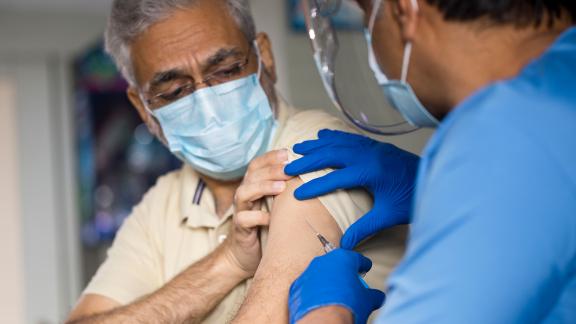How is the NHS performing this winter? 24 to 30 January
Ambulance arrivals to A&E and handover delays
Patients arriving by ambulance to A&E in week ending 30 January were the highest they have been this winter (85,999, up from 85,467 the previous week), although this is lower than the weekly totals seen over the previous three winters:
Of these arrivals, there were 17,288 handover delays of 30 minutes or more (20.1 per cent of arrivals), with 7,202 of those over 60 minutes (8.4 per cent). This follows last week’s trend of worsened performance, after an improvement week ending 16 January. The raw numbers of handover delays over 60 minutes are plotted below:
Discharges
A small improvement in successfully discharging people from hospital was evident, with an average of 12,257 patients medically fit for discharge remaining in hospital per day week ending 30 January compared to 12,819 the previous week.
An average of 42.2 per cent of patients fit to leave were discharged each day, compared to 40.7 per cent the previous week. This is the best since the festive period (when the number of patients no longer meeting the criteria to reside was slightly lower, having been an average of 19,325 week ending 26 December and 16,906 the following week):
These numbers are still concerning, taking up a considerable amount of the NHS’s bed stock; with NHS England asking systems to ‘reduce by half their own number of patients not meeting the reasons to reside criteria’ on 13 December. Despite significant efforts being made by trusts, there were 10,474 patients remaining in hospital no longer meeting the criteria to reside on the day of the letter and on 30 January, there were 12,043. Our members have reported considerable challenges with COVID-19 outbreaks in social care settings affecting ability to discharge, as well as some reports of needing to readmit patients within 28 days of discharge.
We have also heard about innovative approaches to reduce delayed discharges, such as care hotels in the south west designed to free up beds and staff (with plans in place to avoid staffing these hotels using the existing local health workforce) as well as the implementation of bridging services to support patients with domiciliary care services while they await a care package from a local provider. Likewise, some of our members have reported success in working at system level on the discharge issue.
Bed occupancy
Bed occupancy rose slightly this week; with total general and acute bed occupancy at 92.1 per cent (up from 91.6 last week). The below shows a comparison with previous years, again above the occupancy of last winter and now creeping towards levels seen in pre-pandemic winters.
Both paediatric general and acute bed occupancy and adult occupancy increased, up to 71.8 per cent and 93.4 per cent respectively.
What does the current level of absence mean for the NHS Workforce?
NHS staff absence in decline but COVID-19 continues to take a toll, with 40 per cent of those absent due to COVID-19-related reasons. This article presents analysis of NHS England’s most recent situation report (sitrep), focusing on the impact of absence and staff shortages.
Today NHS England release their latest situation report (sitrep). As we emerge from the worst of the recent winter pressures in the NHS, there is an opportunity to look more closely at specific aspects of the service and where they are on the road to recovery as described by the data. In the week that staffing levels have been front and centre for our members following the government U-turn on mandatory vaccination, we focus on the impact of absence and shortages across the NHS.
What does the current data tell us?
Data released today shows that NHS staff absence has been declining over the last few weeks, after having been driven to unprecedented levels by the peak of Omicron infections earlier in January. The number of staff absent due to sickness rose from 58,000 (on an average day) in week ending 5 December, to over 88,500 week ending 9 January. This has seen a downward trend since with an average 70,340 week ending 30 January, a small decrease from the previous week (72,077).
Despite this improving picture, COVID-19 is still significantly impacting the level of absence, with 40.4 per cent of those absent due to COVID-19 related reasons:
*Three trusts have been omitted from these plots due to submitting erroneous data previously or not submitting data for multiple days.
The recent spike in staff absence has been felt more acutely in some regions than others. The seven-day average in the Midlands that peaked at over 19,000 including one day over 20,000 in January. At the end of November this was as low as 12,449, and currently sits at 15,772.
*Three trusts have been omitted from these plots due to submitting erroneous data previously or not submitting data for multiple days.
Wider context
The NHS entered the pandemic with vacancies of nearly 90,000, according to NHS Digital statistics, with a vacancy rate of 7.2 per cent and short of 36,000 nurses and over 8,000 medics. The latest available figures show these considerable holes in the NHS workforce remain, with the vacancy rate increasing to 7.6 per cent (99,640 vacancies), nearly 40,000 of those in nursing.
These underlying workforce challenges followed the NHS into an extremely busy winter. Over the last few months, the service has been working to reduce a record elective waiting list of just below 6 million, seen record ambulance demand including the busiest month ever for life-threatening ambulance call-outs in December 2021, and confirmed COVID-19 patients in hospital rising to over 17,000 in mid-January. Today’s stats also show increased pressure on the ambulance service and A&Es, with 86,000 ambulances arriving to A&E last week (the busiest week recorded in the sitreps this winter, although not historically high).
Despite illness caused by Omicron resulting in shorter hospital stays, the increased burden exacerbated by the need for infection prevention control measures has presented ongoing capacity challenges, alongside the high transmissibility leading to significant staff absence.
Comparison with past winters
Although the latest statistics show absence declining slightly in recent weeks, overall absence remains at an extremely high level from a historical perspective.
Beyond the seasonal fluctuations seen in the five-year view of acute absence figures up to September 2021 shown below, there is an overall rising trend in absence. In April 2020 we saw a record absence rate of 6.5 per cent after the onset of the pandemic (prior to that, the highest rate was 5 per cent in January 2018):
Following the upward trend, we are now seeing average absence figures of over 7 per cent for the NHS as a whole, as recorded for week ending 23 January. This was at almost 9 per cent in both the north west and the Midlands, with absence over 10 per cent in 11 different trusts in those regions. Even accounting for regional variation, these numbers are all considerably higher than the typical rates plotted above. This was even more dramatic earlier in January, with absence approaching 9 per cent nationally for week ending 9 January and over 10 per cent in the northern regions.
This analysis is based on combining two datasets - NHS England’s winter sitrep data alongside NHS Digital workforce statistics. As this data is reported on slightly different bases to the monthly sickness absence statistics, these figures are presented as an indicative comparison of absence rates.
What is the impact on the workforce?
The impact of running a service with long-term vacancies has reduced its resilience to short-term shocks. Although the worst of the pressures this winter appear to have passed, we are still seeing pockets of disruption. For instance, last week saw an acute trust in the north east declare a critical incident as a result of staff absence. Members are also seeing significant variation across disciplines, with some of their highest staff absence rates in nursing and midwifery, estates and ancillary, and additional clinical services.
Contingency measures are also still being required. Members have reported having to step up efforts to secure agency staffing for some of the worst hit areas, such as community nursing, and put in place enhanced payments for difficult to fill shifts. An NHS Confederation member in the east of England reported that temporary staffing levels have increased in their workforce above targets, but still not enough to keep pace with demand, particularly when needing to fill short-notice absence. Other trusts have had to cancel staff training and non-urgent meetings to help release additional capacity.
Critical incidents and the extraordinary contingency measures described are not sustainable. The strain of working in an environment where demand pressures remain high and where there are high vacancies has had a well-documented impact on staff wellbeing. Despite support from NHS England at a national level and NHS Employers’ work directly with employers, the trend is moving in the wrong direction. We have heard from members that sickness absence is not only increased of short-term COVID-19 absence but that in some trusts of absence due to long COVID, mental health and delays to treatment of long-term conditions are increasing too.
Finally, the issue of absence may currently be underestimated. There are growing reports of ‘presenteeism.’ In the 2020 staff survey, 46 per cent of staff said they had gone to work in the last three months despite not feeling well enough to perform their duties. This has historically been quite high and was at 57 per cent in 2019 but fell partly due to the COVID-19 infection control measures leading to staff not attending work if testing positive or self-isolating. It would be a concern if the levels of presenteeism were allowed to rise again and a focus on absence alone is too narrow. Looking more closely at this issue is a key part of NHS Employers work with RAND Europe in the north west to shift from a focus on absence to holistic well-being and a more person centered and flexible approach to supporting staff.
Conclusion
Feedback from members indicates that although absence has improved in the last couple of weeks and there have been innovative attempts to tackle absence and health and wellbeing, absence remains one of the contributing factors to staff shortages, and at one of the toughest times of the year. Reports of organisations urgently needing temporary staff to cover shifts due to absence and being in competition with other trusts on the same patch are also concerning.
The impact of absences shows why a system approach to staffing is needed alongside a fully costed and resourced workforce plan to stop the impact of absence levels causing significant problems.
How is the NHS performing?
View our analysis of the latest NHS performance figures for a rounded view of how healthcare services are coping under immense pressure.



